- Exploration to date at the La Cobaltera project (a historic high-grade cobalt producer) has identified two main trends: a >12 km long cobalt-rich (+copper) vein system, and a 20 km long copper-rich (+cobalt) three-zone vein system. The project does not yet have a resource estimate; drilling is planned to define one, with production targeted within four-five years.
- Geological consultants SRK conducted a study for COBA based on regional mineralization, and historical production data. The study outlined a conceptual model for a 10–15 year operation, with an estimated CAPEX of $300–400M for a 10,000 tpd processing plant, producing 5–10 Mlbs of cobalt, and 50–60 Mlbs of copper annually.
- COBA has partnered with Glencore (LSE: GLEN) for concentrate offtake, and US Strategic Metals (USSM) for downstream cobalt and copper processing. Concentrates from the La Cobaltera project are expected to be exported to the U.S. for refining.
- The U.S. EXIM Bank has issued a Letter of Interest for up to $317M, potentially funding approximately 80% of the project’s initial CAPEX — a strong endorsement of the project’s potential.
- Upcoming catalysts include a maiden resource estimate in 2026, and a Preliminary Economic Assessment (PEA) in 2026–2027.
Risks
- Commodity prices
- No resource or economic study
- Exploration and development
- Permitting
- Access to capital and potential for share dilution
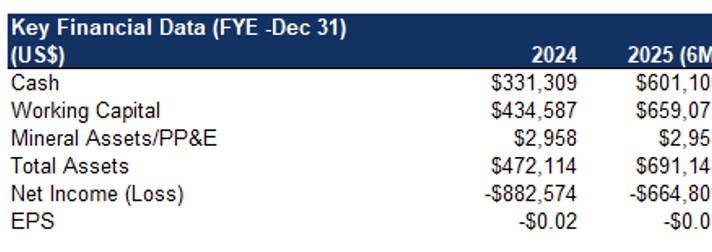
Price and Volume (1-year)
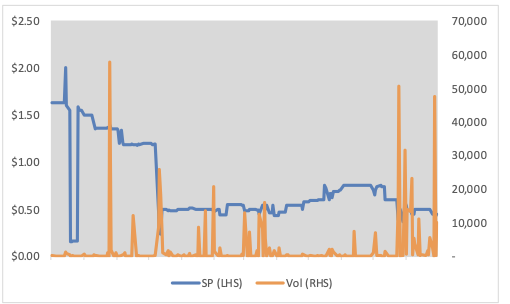
| |
YTD |
12M |
| COBA |
-36% |
-78% |
| OTCQX |
26% |
16% |
Cobalt Primer
Cobalt is a hard, lustrous metal with a high melting point, primarily used in lithium-ion batteries for electric vehicles and portable electronics, and in superalloys for high-performance applications. Demand is also rising from AI and advanced computing, where cobalt is used in batteries and critical components.
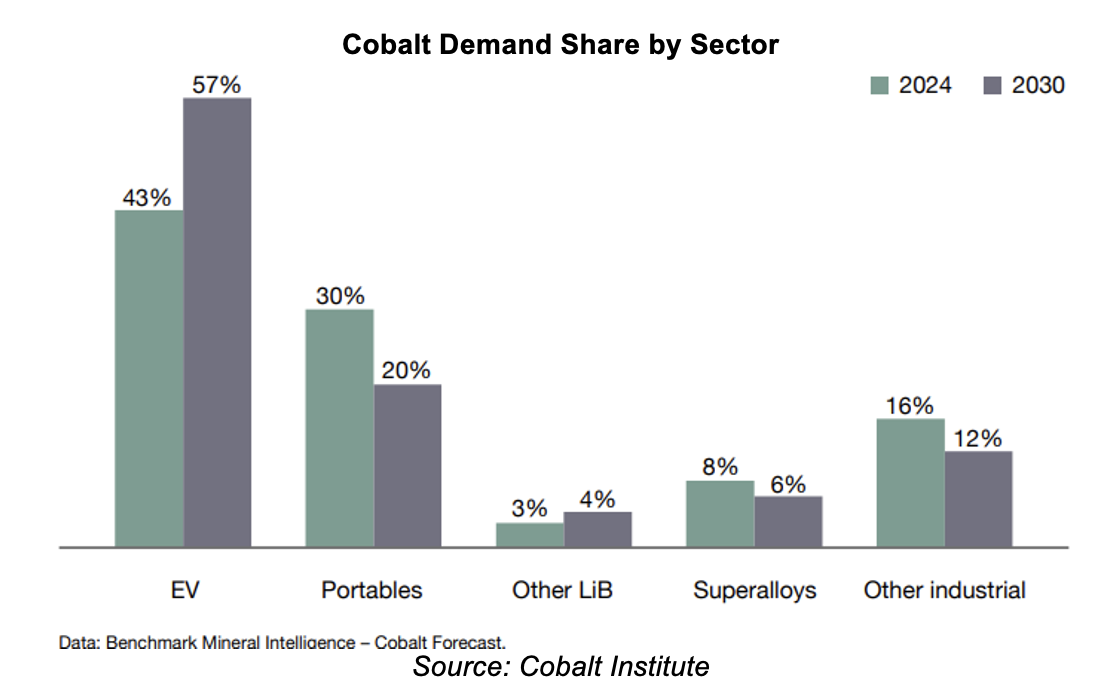
Demand: Cobalt-containing batteries dominate the EV market in North America and Europe but are a minority in China, where cobalt-free Lithium Iron Phosphate/LFP batteries prevail. Globally, cobalt-containing batteries account for 53% of the EV battery market. However, in the portable battery sector, cobalt-containing batteries dominate, accounting for 96% of all batteries.
While LFP batteries are cheaper and have longer lifespans, we believe cobalt-containing chemistries such as NMC and NCA remain critical for their higher energy density, longer range, lighter weight, and better cold-weather performance. Therefore, we have a positive outlook on cobalt-containing batteries and believe LFP and cobalt-containing chemistries will coexist long term.
Supply: The DRC holds the world’s largest cobalt reserves and is the top cobalt ore producer, while China leads in refining and is the largest consumer. Global cobalt supply remains vulnerable due to heavy reliance on the DRC, where mining is linked to political instability, unsafe working conditions, and human rights concerns, as well as China’s dominance in processing, particularly given recent elevated geopolitical tensions. To address these risks, western countries are actively pursuing alternative, secure, and sustainable supply sources.
Cobalt is designated a Critical Mineral by the U.S., EU, UK, Canada, Japan, Australia, and China
Global cobalt consumption is about 220 kt per year, with batteries accounting for 76% of demand. Cobalt-containing batteries vs LFP
The DRC accounted for 76% of global production in 2024. The cobalt market has been in surplus since 2022, with a 36 kt surplus in 2024, equivalent to 15% of demand
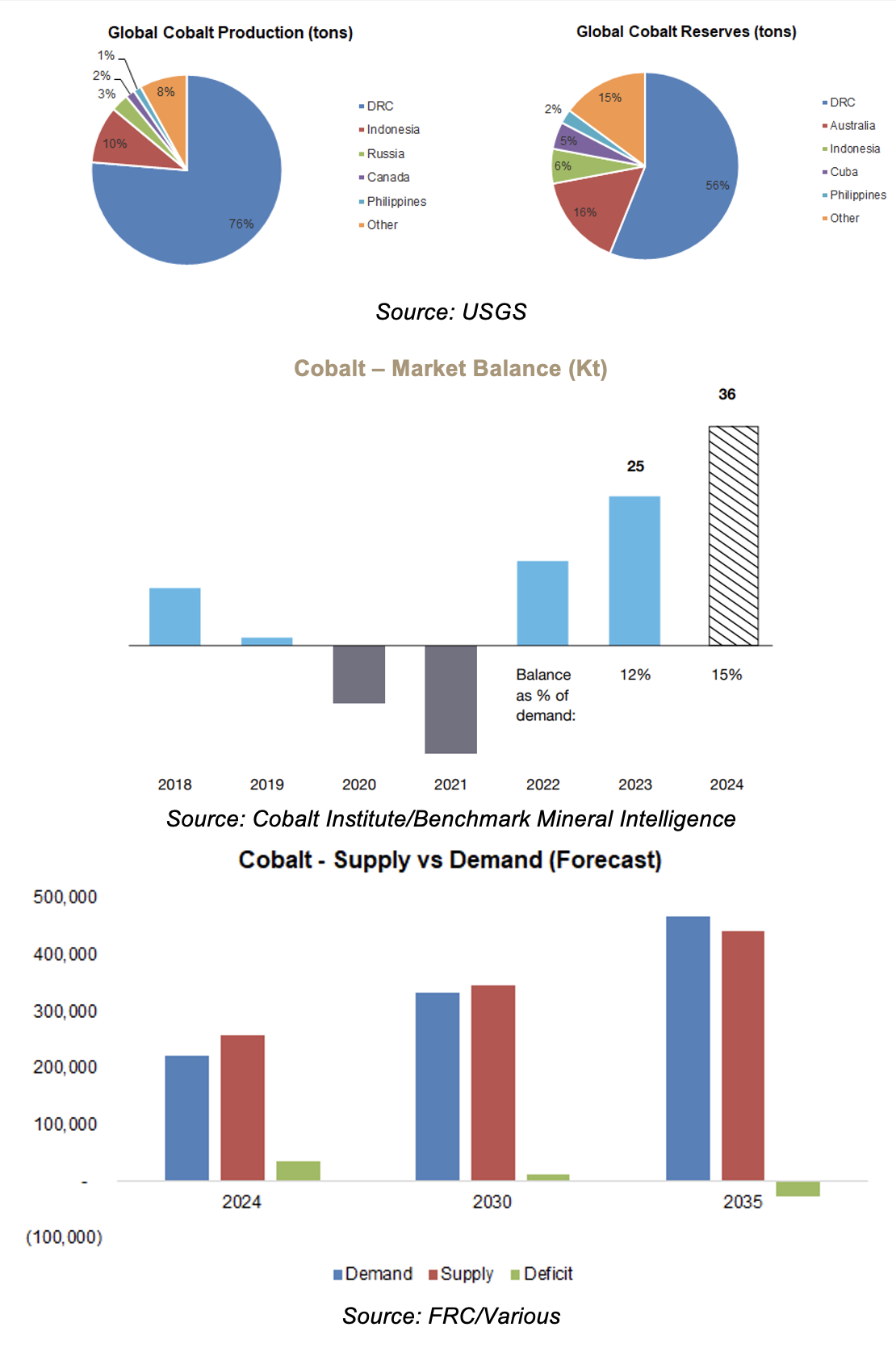
Per consensus forecasts, demand is expected to grow 7% p.a., while supply will rise 5% p.a. over the next decade, pushing the market from surplus to deficit by the early 2030s
Cobalt prices have been volatile over the past 15 years
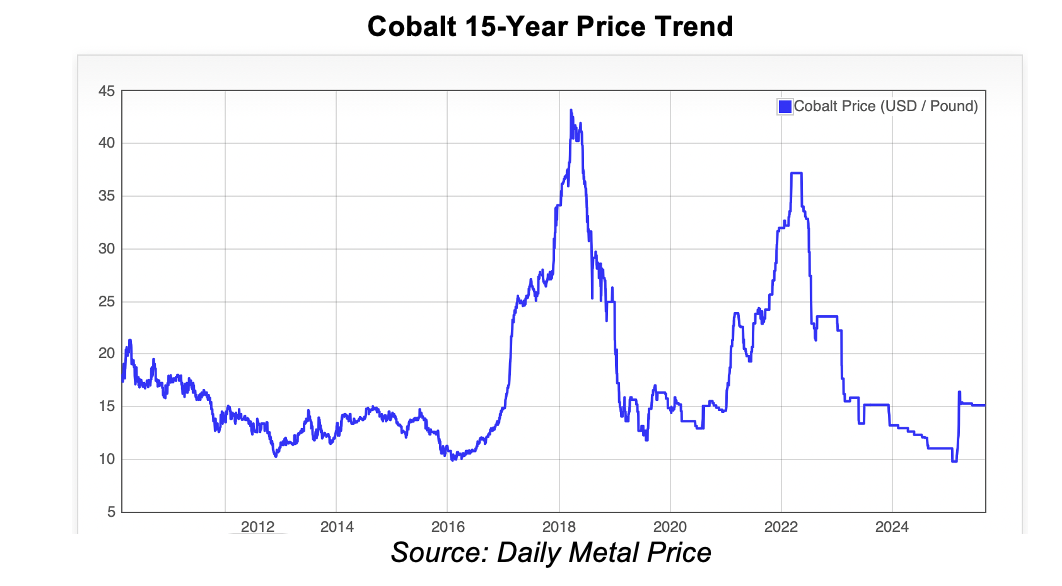
After steep declines since 2022 from oversupply and weaker EV demand, prices rebounded in early 2025, up 50% YTD to $15/lb, after a DRC export ban tightened supply
La Cobaltera Cobalt-Copper Project (100% owned)
COBA’s La Cobaltera project, located 700 km north of Santiago, spans 3,007 ha in the historic San Juan cobalt–copper mining district in the Atacama region
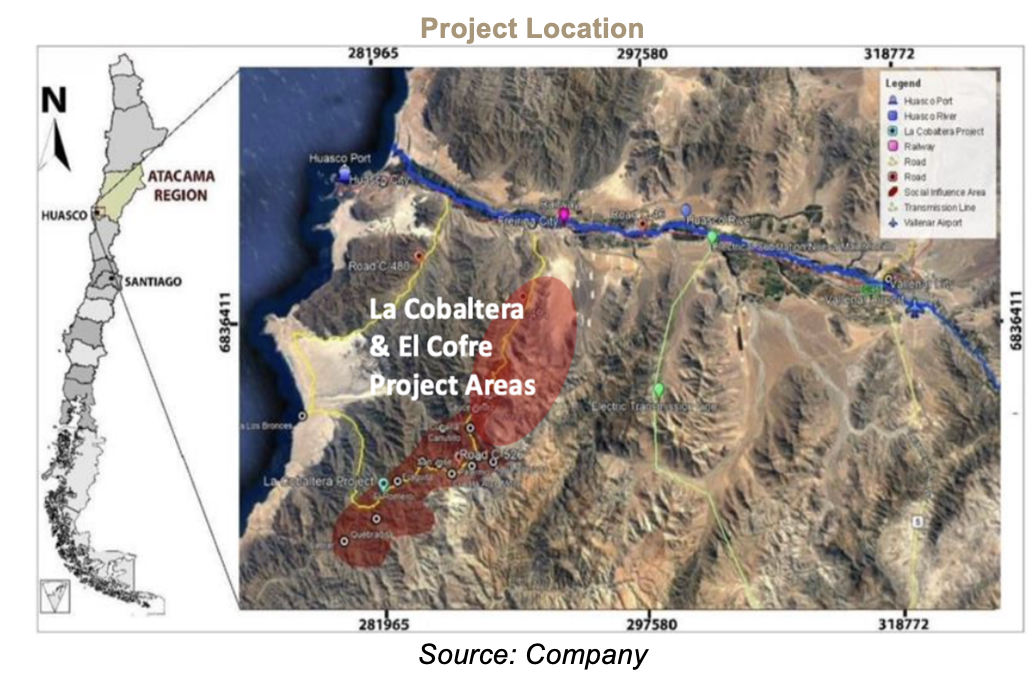
The San Juan district, just 10 km from the coast and 30 km from the Port of Huasco, benefits from robust infrastructure, including roads, rail, processing facilities, power (15 km away), and skilled labor
The Atacama region is home to Lundin Mining’s (TSX: LUN) Candelaria Copper Complex and Hot Chili’s (ASX: HCH) advanced-stage Costa Fuego copper–gold project. San Juan hosts several cobalt-rich zones, including Mineral de Labrar, Quebradita, El Romero, Fraguita, and La Cobaltera (including Rosa Amelia), with over a century of cobalt and copper production history. Historic cobalt output was modest, around 7,000 tonnes, but of exceptionally high grade, ranging from 1% to over 15%, well above the global average of 0.10–2.00% for primary cobalt deposits, and 0.05–0.40% for by-product cobalt.
Chile is the world’s top copper producer, and the second-largest lithium producerLa Cobaltera was the largest production area in the historic San Juan cobalt–copper mining district
The company gained control of the project in 2018 and is focused on consolidating land packages in the region to create a district-scale asset
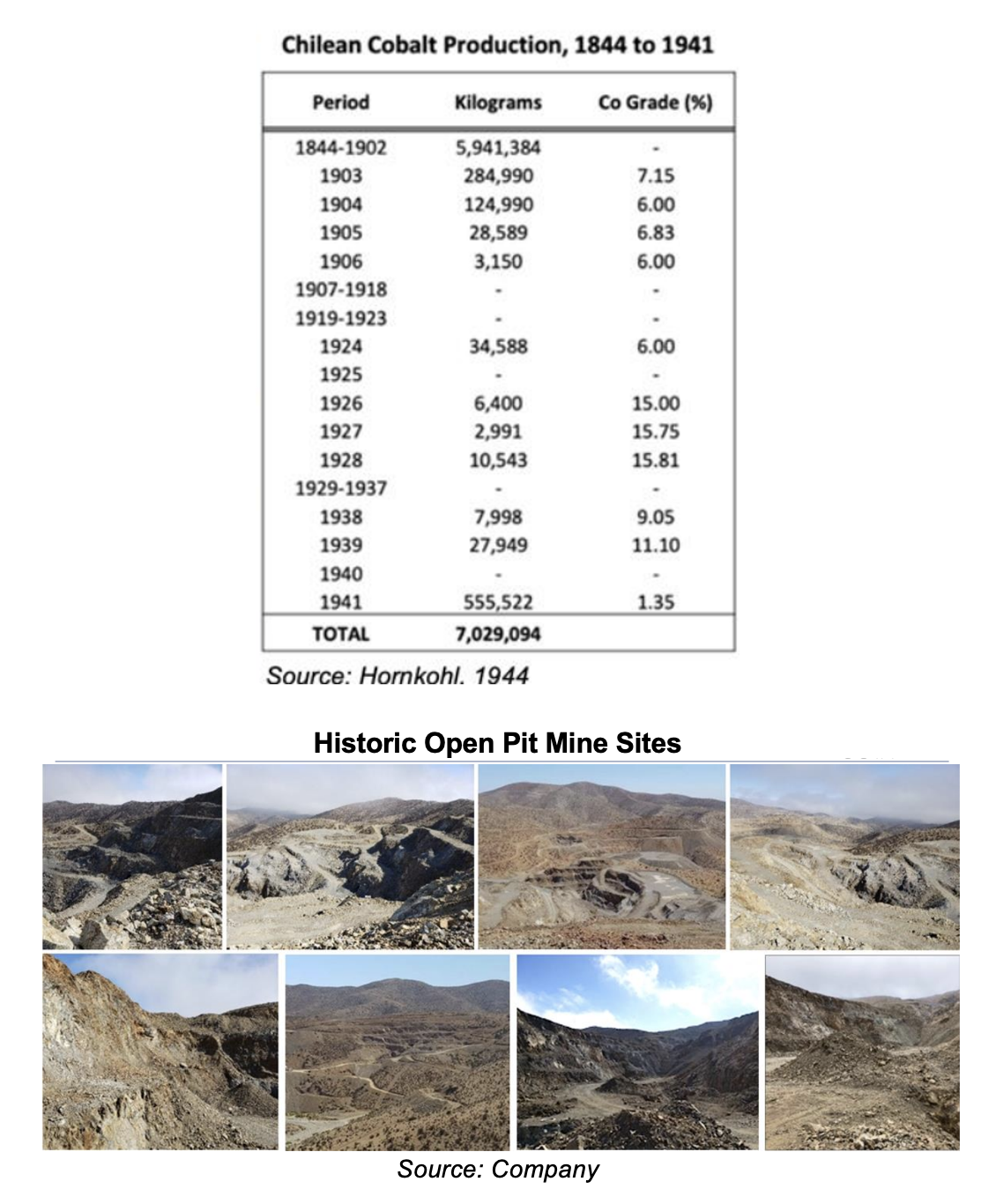
History, Mineralization, and Infrastructure
Cobalt, rarely found in pure form, is sourced from primary and secondary deposits. Primary cobalt deposits, where cobalt is the main economic mineral, are extremely rare. In contrast, 99% of global cobalt production comes from secondary deposits, where cobalt is a by-product of nickel and copper mining
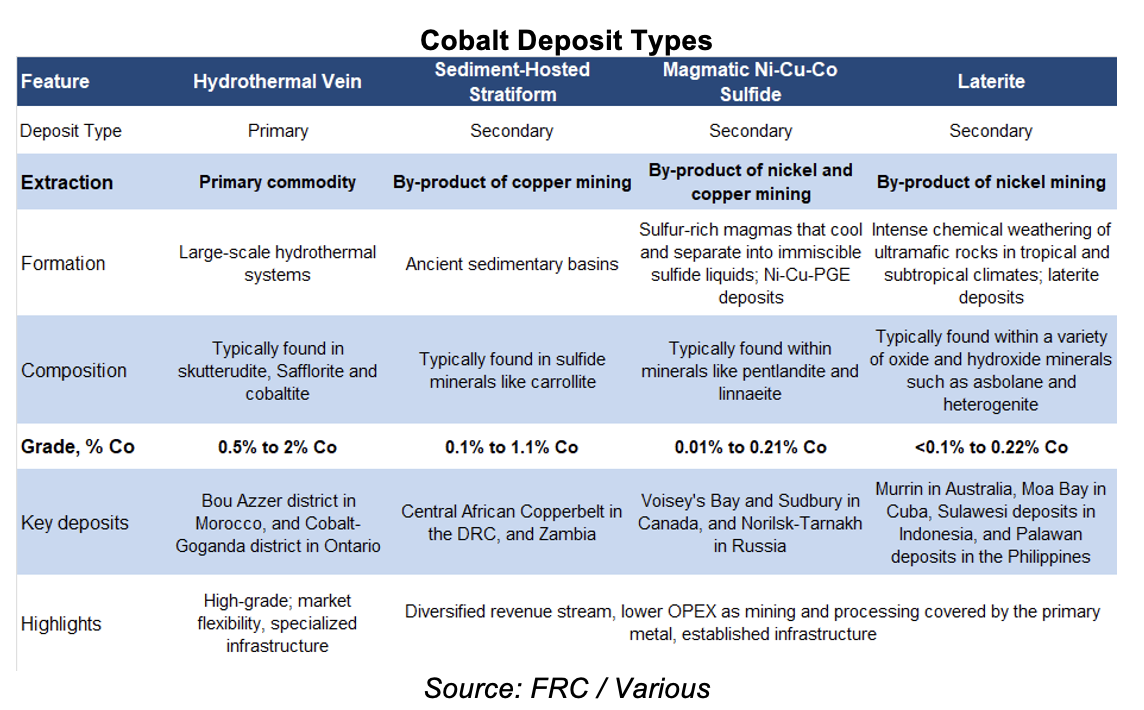
Hydrothermal cobalt deposits, the only type where cobalt is the primary metal, are rare but typically high-grade, enabling optimized processing and lower OPEX
La Cobaltera hosts a hydrothermal system featuring two main trends: a cobalt-rich (+copper) vein system extending over 12 km, and a copper-rich (+cobalt) three-zone vein system spanning 20 km. Mining began in the 1840s through both open-pit and underground methods, targeting oxide and sulphide mineralization.
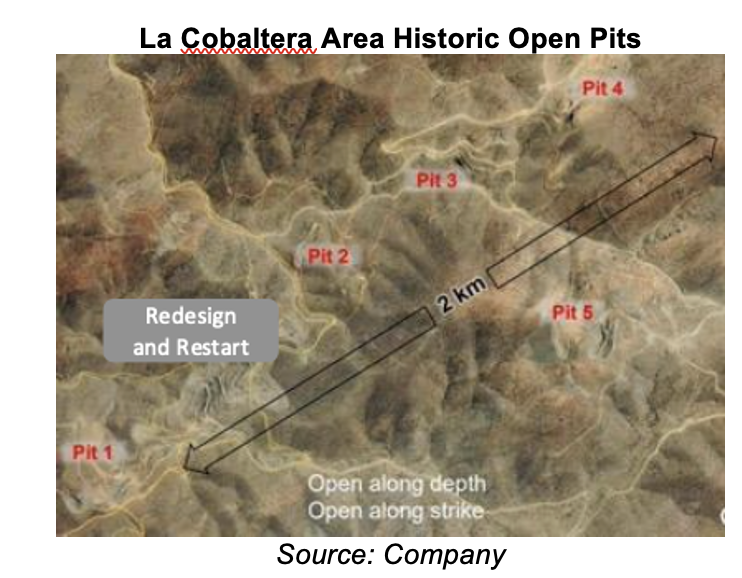
High-grade cobalt was mined from the 1840s to 1944, with reported grades ranging from 1.3% to 15.8% Historic open pits along a 2 km trend represent less than 20% of the total length of the cobalt-rich vein system
Exploration
Despite a 100+ year mining history, the district lacked modern exploration until COBA acquired the project. In 2018–2019, in collaboration with SRK Consulting, the company conducted a comprehensive program, including mapping, trenching, and drilling to validate historical data, and assess potential open-pit oxide and underground sulphide resources.
From 2018–2019, the company drilled 96 holes totaling 21,943 m
Management is leveraging results from the 2018–2019 program, along with new AI and machine learning tools, to identify targets and potentially delineate a medium-sized, high-grade cobalt–copper oxide deposit.
Development Plans
COBA is planning a drill program in 2026 ahead of completing a maiden resource estimate. To develop the project, management is considering a phased strategy: phase one would target near-term production by reopening historic pits and mining oxides, followed by phase two mining of transition and sulphide zones. This phased approach offers lower CAPEX, and a faster route to production.
Management plans to mine the oxide zone first, offering a lower-CAPEX, and a faster route to production
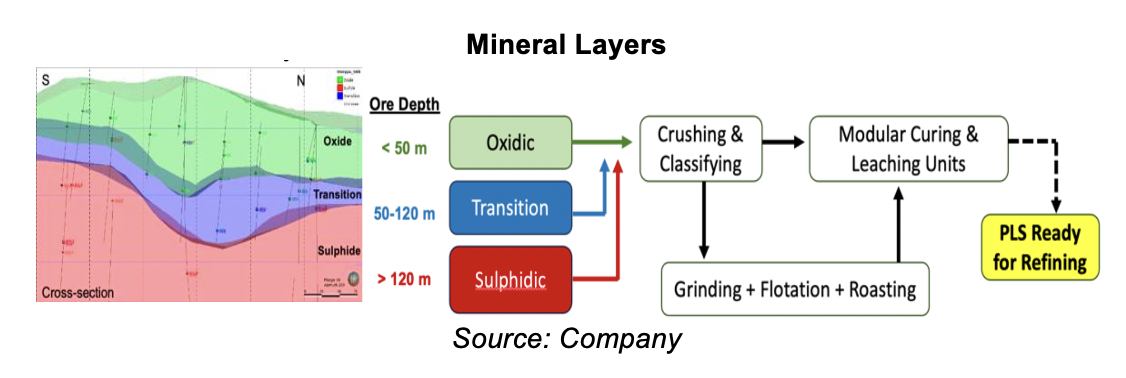
In 2019, SRK Consultants conducted a study for COBA. Based on regional mineralization, and historical production data, SRK developed a model for a potential 10-15 year operation. We note that this study used very preliminary, speculative estimates, and was not backed by a formal resource estimate. However, we believe it provides a useful benchmark for our valuation, presented later in this report.
SRK estimated a 10-15 year operation per 2 km strike, with CAPEX of $300–400M for a 10,000 tpd operation, producing 3,000–5,000 tpa cobalt, and 20,000–25,000 tpa copper
Management aims to reach production within four to five years
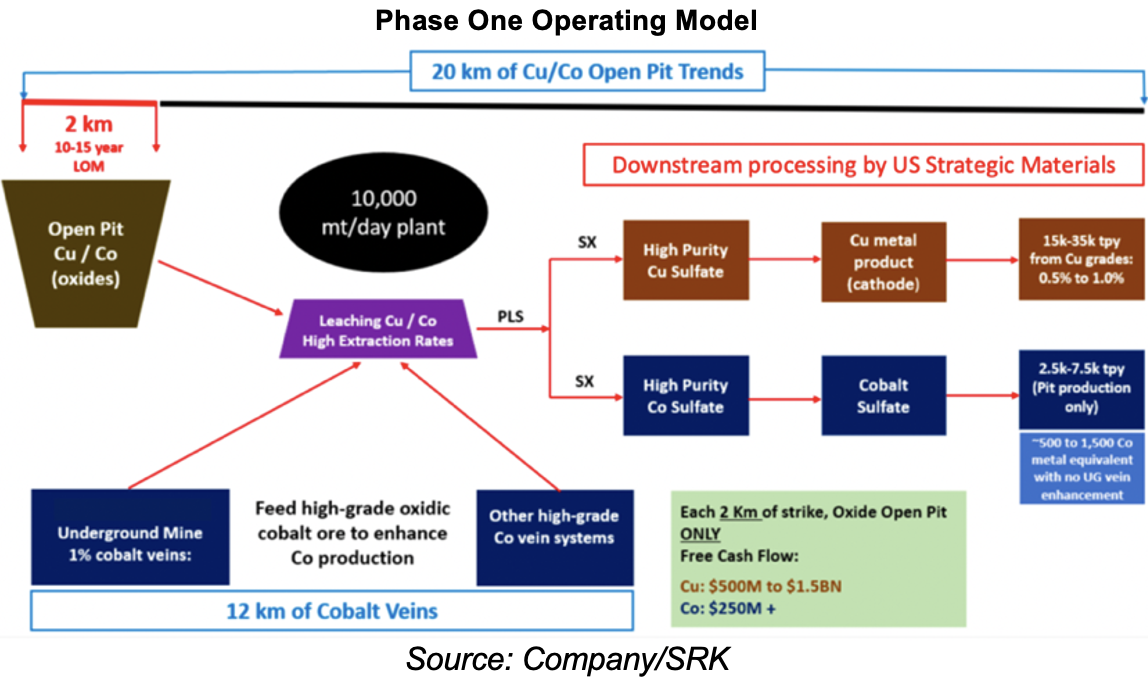
Management’s near-term plans include completing a resource estimate in 2026, followed by a Preliminary Economic Assessment (PEA) in 2026–2027.
Key Partnerships to Develop an Americas Cobalt Supply Chain
- In 2024, COBA received a $317M LOI from the Export-Import Bank of the U.S. (EXIM) for a potential debt funding package to cover most of the estimated $300–400M CAPEX for a 10,000 tpd operation, as projected by SRK. The company plans to submit a formal application to EXIM, potentially after completing the maiden resource estimate and PEA.
- The company has formed strategic partnerships with Glencore (LSE: GLEN) for concentrate offtake, and US Strategic Metals (USSM) for downstream cobalt and copper processing in the U.S. They are exploring options to export La Cobaltera concentrates to USSM’s integrated processing site in Missouri.
We believe these deals strongly validate COBA’s portfolio and strategic vision
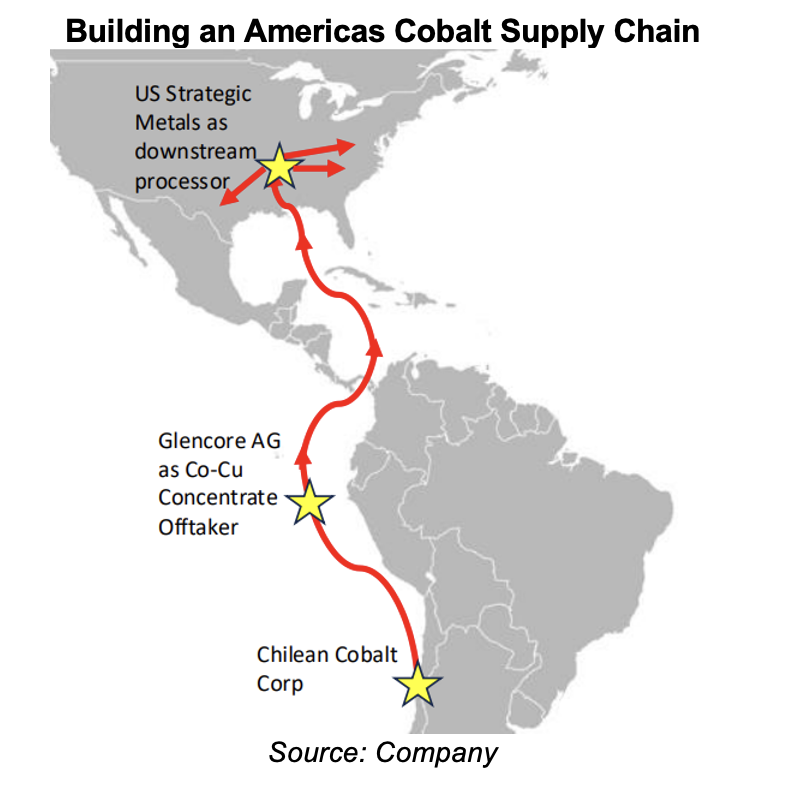
Cobalt-copper concentrates from La Cobaltera will be exported to the U.S. for processing. Multiple catalysts
Upcoming Catalysts
- Complete a pilot exploration program using AI and machine learning tools.
- Conduct drilling ahead of a resource estimate (2026).
- Complete a PEA in 2026–2027.
- Strategic district consolidation in San Juan: Last month, the company entered a definitive agreement to acquire 3,742 ha of exploitation claims, including 372 ha adjacent to existing holdings, and 3,370 ha containing the El Cofre project, a copper–cobalt–gold target with two drill-ready prospects. Management aims to advance exploration at El Cofre, considered a likely extension or analogue of the San Juan district.
El Cofre hosts two copper–cobalt–gold targets identified through prior aeromagnetic, IP surveys, and trenching
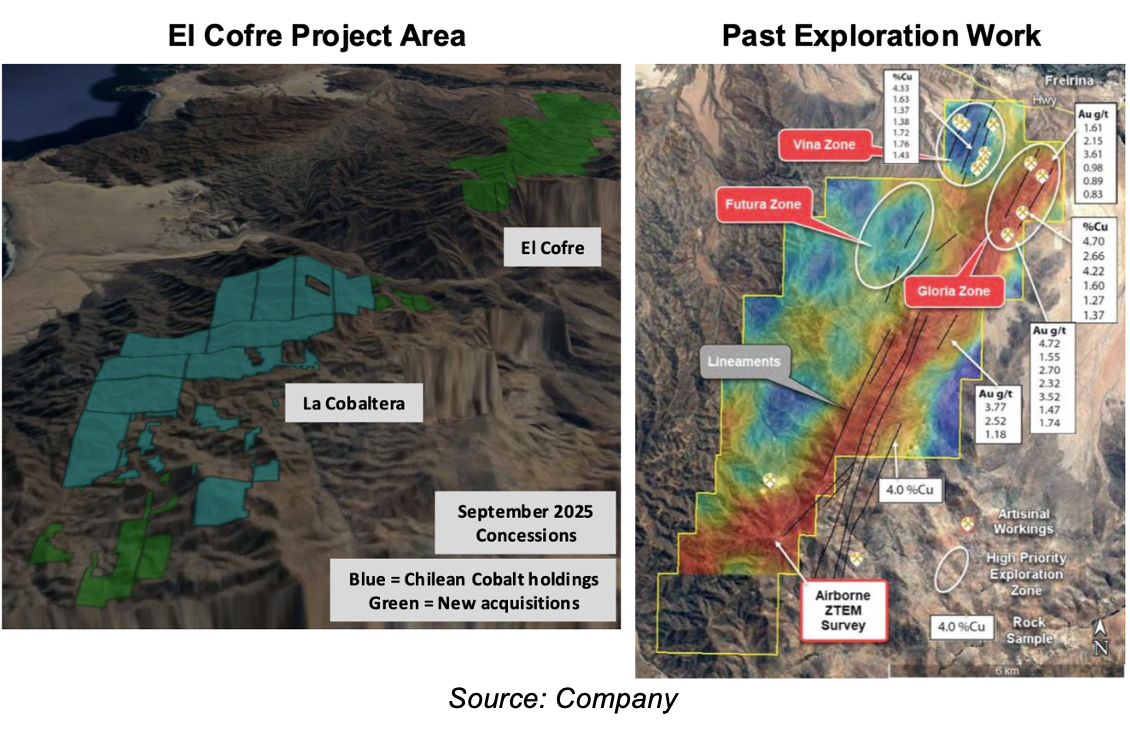
COBA plans to keep pursuing acquisitions to build a district-scale asset in San Juan.
Management and Board
Management and board own 23%. Two out of five directors are independent
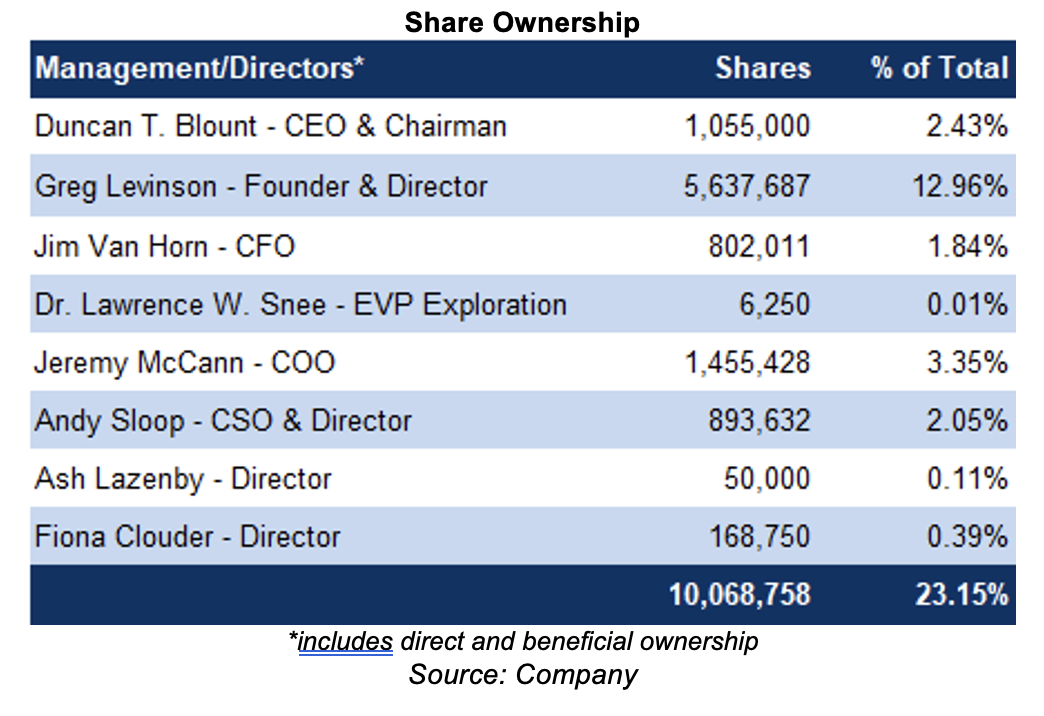
Brief biographies of the management team, as provided by the company, follow:
Duncan T. Blount, CEO & Chairman
Mr. Blount has over 18 years of experience in commodities and global natural resources. Prior to joining Chilean Cobalt, he served as CEP and Director of Decklar Resources, an independent oil and gas exploration production company operating in Nigeria. He also held the same executive roles when the company operated under its former name, Asian Mineral Resources, which managed a nickel-copper-cobalt mine in northern Vietnam. He also held key positions at Redwheel (formerly RWC Partners) and Everest Capital, where he has developed portfolio strategies centered on commodities and natural resources.
Greg Levinson, Founder & Director
Mr. Levinson has over 30 years of finance and capital markets expertise, and was founder of Chilean Cobalt in 2017. Prior to Chilean Cobalt, he spent 20+ years within the multi-strategy hedge fund and proprietary trading community. He was a founder of Polaris Advisors, an asset manager specializing in convertible arbitrage, equity, and derivative strategies. Prior to his hedge fund work, Mr. Levinson was a Managing Director at BNP/Paribas, leading groups in both proprietary trading and client managed assets.
Jim Van Horn, CFO
Mr. van Horn has over 25 years of experience in accounting, audit, and compliance. He has been actively licensed as a CPA in the state of Oregon since May 1999. He served in Controller and CFO roles in the parking management and investment management space from 1999-2020.
Dr. Lawrence W. Snee, EVP for Exploration
Dr. Snee is a certified professional geologist (CPG-10085 and Qualified Person) with over years of experience on a broad array of Us government, academic, and foreign projects. He is a specialist in field geology, mineral resource assessment, petrology, geochemistry, isotope geology, structural geology, tectonics, economic geology, and the geology of gemstone deposits and has been a manager of over 100 scientists, technicians, and administrative personnel in the U.S Geological Survey (USGS).
Jerremy McCann, COO
Mr. McCann has served as Chief Operating Officer of Chilean Cobalt since December 2017. He is also the COO and a Founder of Genlith Inc., a holding company focused on clean energy, energy materials, and battery technology and a former affiliated of Chilean Cobalt. Prior to his current role, from 2008-2017, he was COO for Schooner Investment Group LLC, a registered investment advisor to multiple registered mutual funds.
Andy Sloop, CSO & Director
Mr. Sloop has served as an Independent Director, ESG Committee Chair, and Audit Committee Member at Chilean Cobalt since October 2021. He is a recognized sustainability expert with over 30 years of experience developing and managing innovative programs and initiatives across the public, private, and non-profit sectors. From 2016 to 2024, he served as the Global Director of Zero Waste & Circularity at Nike. Additionally, Mr. Sloop is a Strategic Advisor to Airbuild.
Ash Lazenby, Director
Mr. Lazenby is an experienced critical minerals trader, battery supply chain investor, and strategic advisor. For the past eight years, he was at Glencore, initially in Switzerland across finance and global cobalt trading functions, and then in New York as a senior critical minerals trader running the North American cobalt business and expanding the lithium portfolio.
Fiona Clouder, Director
Ms. Clouder has wide experience of Latin America, both as a diplomat and now through her work in the private sector. She was the UK’s Ambassador to Chile from 2014 to 2018; and then regional Ambassador, Latin America and Caribbean, COP26, from 2020-2022, driving diplomatic engagement, at the top of governments and business, for a Net Zero world.
Financials
At the end of Q2-2025, COBA had $0.60M in cash. In-the-money options can bring in $1.4M
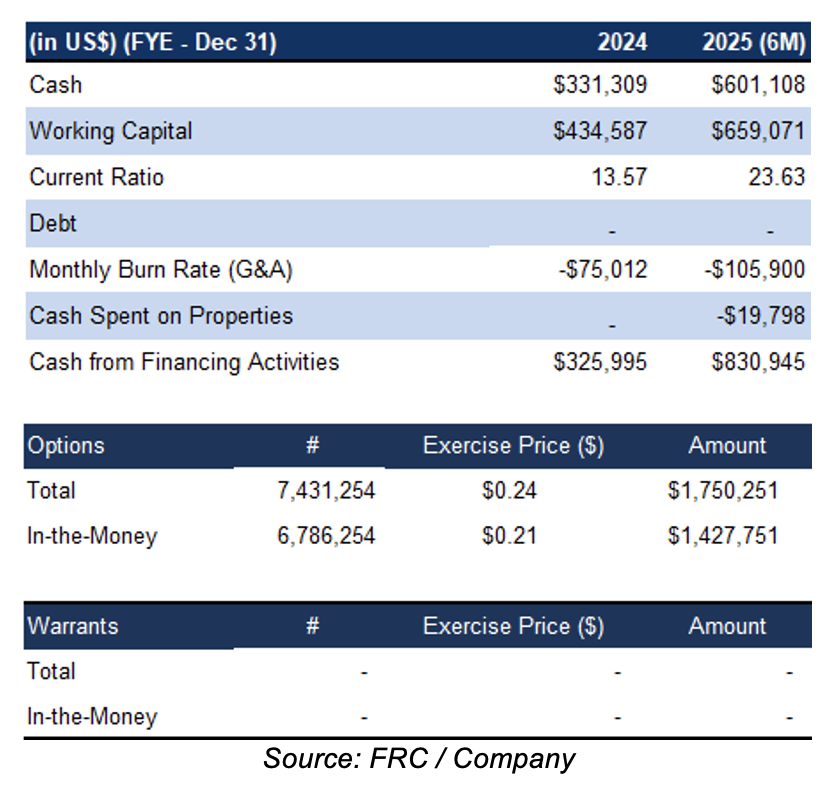
FRC Projections and Valuation
Our DCF valuation returned a fair value estimate of $1.28/share. Even though the project does not have a resource estimate, we are using SRK’s study as a benchmark, but applying more conservative assumptions
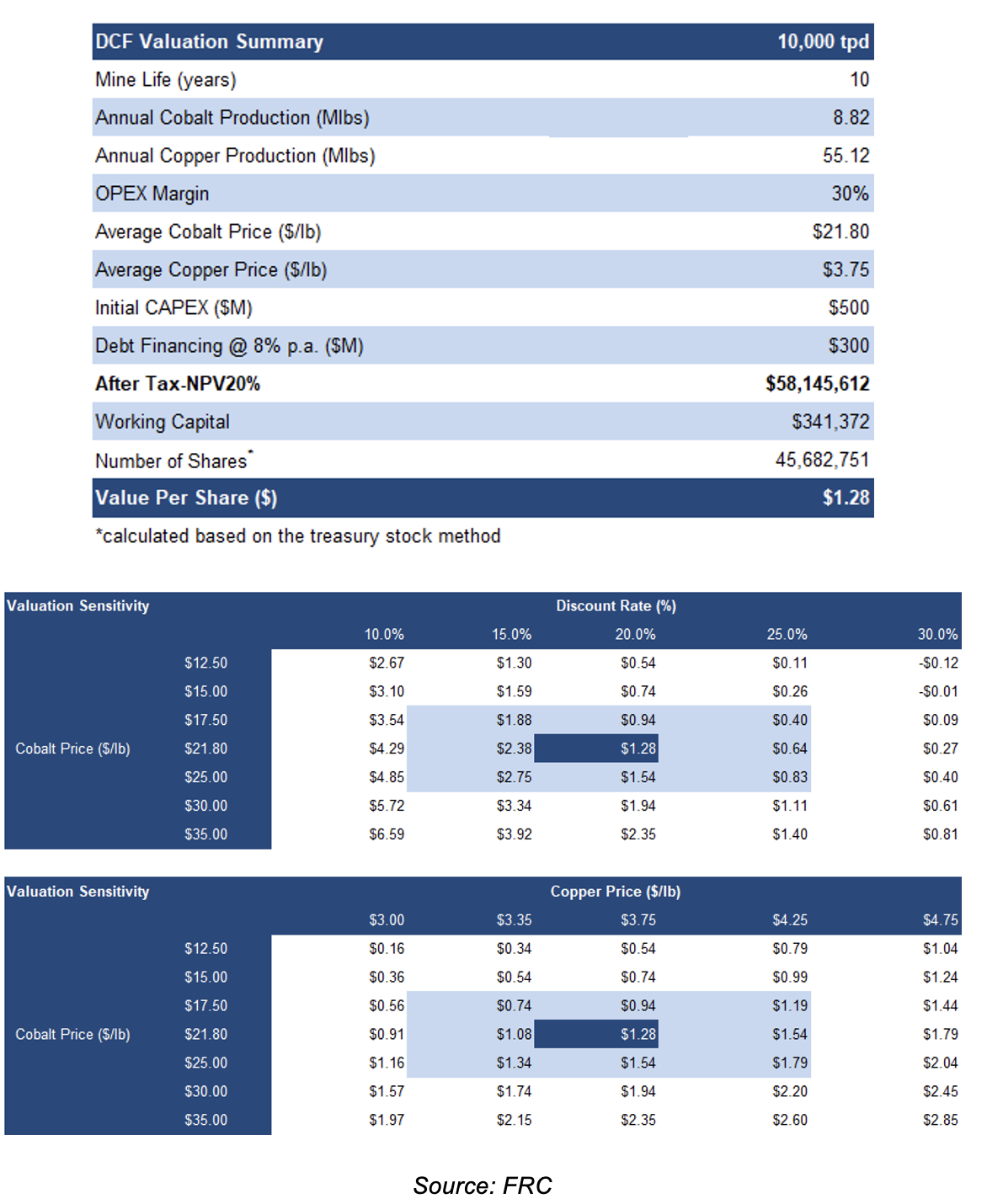
We assume 60% of CAPEX will be debt financed via EXIM Bank. We are using a 20% discount rate (versus our usual 11.6%) to reflect financing and execution risks, as well as the absence of a resource estimate or economic study
We are initiating coverage with a BUY rating, and a fair value estimate of $1.28/share. COBA offers exposure to a district-scale cobalt-copper project aligned with the global shift toward secure, ethical, and diversified critical mineral supply chains. Backed by partnerships with Glencore and US Strategic Metals, and potential financing support from the U.S. EXIM Bank, the company is well positioned to advance its La Cobaltera project toward development. With cobalt prices rebounding and demand expected to tighten by the early 2030s, upcoming milestones such as the maiden resource estimate, and PEA, could serve as key value catalysts.
Risks
We believe the company is exposed to the following key risks (not exhaustive):
- Commodity prices
- No resource or economic study
- Exploration and development
- Permitting
- Access to capital and potential for share dilution
- FOREX




















